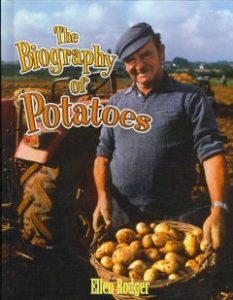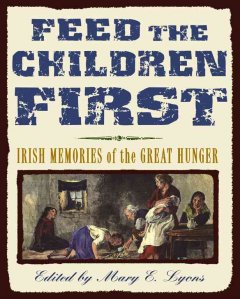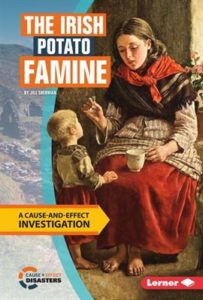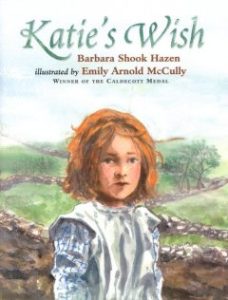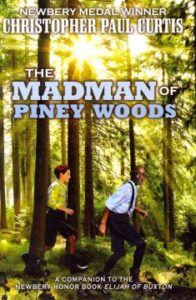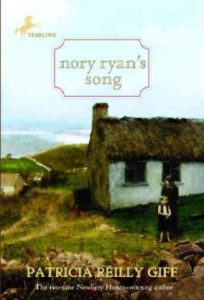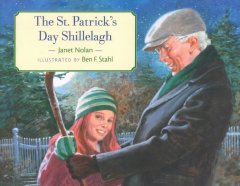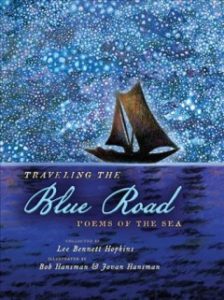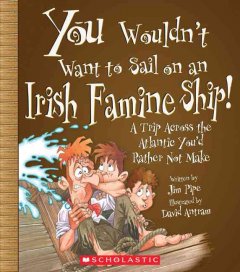175 years ago, The Dublin Evening Post reported a serious failure in the potato crop. Potatoes were not a cash crop, but the food eaten by tenant farmers and farmworkers who grew cash crops to pay the rent. The potato blight of 1845 was the start of the Great Hunger, or the Irish Potato Famine, a period of years when the potato crop failed and over a quarter of the population of Ireland—millions of people—would either die or leave for other countries. A large percentage of the emigrants settled in the United States, including some of my family.
We have some excellent resources for young people learning about the history of the famine, including eResources you can use without leaving home:
Primary Search (part of EBSCOhost Research Databases) has some of the most interesting articles, drawn from a no-longer-published children’s history magazine called Calliope. It was published by Cricket Media, which also publishes magazines like Ask (arts and science for ages 6–9), Cobblestone (American history for ages 9 to 14), Faces (people and places for ages 9–14), Muse (STEAM for ages 9–14) and the children’s literary magazine Cricket (and equivalents for younger ages, like Babybug, Ladybug and Spider). You can also find articles in encyclopedias from Scholastic GO! and World Book.
Our newest eResource, Scholastic Teachables, has a read-aloud play for students in grades 4–8 about Irish immigration, one of five such plays about different American immigrant groups. The short reader’s theater plays also include background information, a bibliography and suggestions for additional activities.
Here are some books you can also check out on this subject!
The Biography of Potatoes by Ellen Rodger
Suggested for grades 3–6
This book describes how potatoes are grown and harvested and discusses the historical use of the potato, its influence against famine in Europe and its role in the 1845 Irish famine. It also explores the many uses of the vegetable.
Find It Now
Feed the Children First: Irish Memories of the Great Hunger edited by Mary E. Lyons
Suggested for grades 4–8 or ages 9–12
This book discusses the Irish potato famine of the 19th century using primary accounts.
Find It Now
The Irish Potato Famine by Jill Sherman
Suggested for grades 4–6
In the mid-1840s, potato blight ruined the crops of impoverished farmers across Ireland. Many families went hungry. As the government struggled to address the problem, disease struck down people weakened by starvation. Would the country ever recover?
Find It Now
Katie’s Wish by Barbara Shook Hazen, illustrated by Emily Arnold McCully
Suggested for grades kindergarten–3
Soon after Katie wishes for her potatoes to disappear during dinner, a potato famine ravages her native Ireland forcing her to leave for America.
Find It Now
The Madman of Piney Woods by Christopher Paul Curtis
Suggested for grades 4–6 or ages 8–12
Even though it is now 1901, the people of Buxton, Canada (originally a settlement of runaway slaves) and Chatham, Canada are still haunted by two events of half a century before—the American Civil War and the Irish potato famine—and the lasting damage those events caused to the survivors.
Teachers can find a discussion guide for this book (and two other novels by Curtis) on the Scholastic website and more resources on TeachingBooks (some of which require an account). As a workaround, you can access resources related to author Christopher Paul Curtis for free through the Coretta Scott King Awards Curriculum Resource Center. To find him quickly, use the filtering tool on the left to select the historical fiction genre, and Curtis will be at the top of the list.
Find It Now
Nory Ryan’s Song by Patricia Reilly Giff
Suggested for grades 4–8
When a terrible blight attacks Ireland’s potato crop in 1845, 12-year-old Nory Ryan’s courage and ingenuity help her family and neighbors survive.
You can find tools such as a teacher’s guide on the Penguin Random House website and additional resources on TeachingBooks.
Find It Now
The St. Patrick’s Day Shillelagh by Janet Nolan
Suggested for grades kindergarten–4
On his way from Ireland to America to escape the potato famine, young Fergus carves a shillelagh from his favorite blackthorn tree, and each St. Patrick’s Day for generations, his story is retold by one of his descendants.
Find It Now
Traveling the Blue Road: Poems of the Sea collected by Lee Bennett Hopkins; illustrated by Bob Hansman & Jovan Hansman
Suggested for ages 8–12
Traveling the Blue Road is a carefully curated collection of kid-friendly poetry about the ever inspiring subject of the ocean. Themes include pilgrimages, migration (including a “coffin ship”), culture and more.
Find It Now
You Wouldn’t Want to Sail on an Irish Famine Ship! A Trip Across the Atlantic You’d Rather Not Make by Jim Pipe
Suggested for grade 3 and up
A look at Irish immigrants who came to the United States to escape the potato famine. If you can get past the jokey approach to a serious subject, there is plenty of solid information. For example, the book lists well-known Americans who were (or were descended from) famine survivors (although the list omits women such as Mother Jones).

